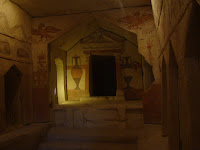




We left the En Gev resort area on the Eastern shore of the Sea of Galilee this morning. It was already beginning to get hot. Yesterday it was 106 degree at the resort area. I was really looking forward to getting back to Jerusalem up in the Hills of Judah. We had several places that we were to make stops as we traveled south toward the city.
Our first stop the Cliffs of Arbel. These cliffs are easily visible from the Sea of Galilee as they look over the Western side of the lake just north of Tiberius. From these mammoth cliffs one can easily see the path of the Patriarchs highway as it moves northeast of Mt. Tabor past the Horns of Hittim and through the cliffs of Arbel onto the Plain of Gennesaret. As the highway continued it would move north past the Sea of Galilee and onto Hazor. On the far end of the Gennesaret plains is the biblical town of Magdala the hometown of Mary Magdalene. The southern end of the Arbel cliffs rise up from the valley below with fields of wheat and barley being cultivated up to the National Park line. The view from this point is stunning and encompasses much of the area Jesus did ministry while in Galilee.
Our next stop took us to the city ruins of Zippori (Sepphoris). The city was the first capital of Herod Antipas who was granted the Galilee to rule after his father’s death in 6AD. He eventually moved his capital to the city of Tiberius on the Western side of the lake. Zippori was the main headquarters for the Crusaders as they embarked upon their fatal journey to defeat at the hands of the Muslims. Before the Great Rebellion of 66-73AD, the Jewish residents of Zippori made a pact with the Romans which did spare their lives and their city as the rest of Israel including Jerusalem was destroyed. The Jews lived in the upper end of the city. The ruins at the lower end of the city provide us with beautiful mosaics. The city had a north south street (Cardo) as well as east west street called the Decomono. The streets where stone with walk ways under columned porticos on either side for pedestrians. Besides the huge mosaics that have been unearthed at this site, the most interesting to me personally were the indentions found in the road made by the wheels of chariots over heavy use.
After lunch in the Harod Valley near the spring where Gideon’s men drank, we moved onto the ruins of Beth-shan. Beth-shan was the Roman city of Scythopolis, the capital of the Decapolis and the only one on the east side of the Rift Valley. The ruins were from the Byzantine period again showing the main Cardo (north south) road and the Decomono. The Cardo was lined again by walk ways under porticoes. This city also possessed a sewer system with the road being crowned to move rain water to the sides. The main road proceeds north until it hits Tel Beth-shan the older part of the city under a huge Tel. On the Tel there are remains of 26 different cities that had been built and destroyed, including the city on the east side of the Tel that is from The United Monarchy time. This is the city where the Philistines took King Saul’s and Jonathan’s bodies and hung them for all to see. The city does sit in the Beth-shan Valley where many Israelites would see the bodies. Saul and Jonathan were killed on Mt. Gilboa and their bodies taken to Beth-shan and hung as a warning to all Israel. One of the final things we were able to see at this site was the latrines (men) that lined two walls of a great room. They were humorous at the least.
My impression for the day center once again around the reality that biblical events took place on these sites many years ago. They once again have added clarity and color to the account of both the Old and New Testament.
Picture One - View of the Genessaret Plain (Magada and north end of the Sea of Galilee from the Cliffs of Arbel
Picture Two - ibid
Picture Three - Chariot ruts in the road at Sepphoria
Picture Four - Theater at Beth Shan
Picture Five - View from the Theater with the OLD Tel Beth Shan in the background. This was the city where Saul and Jonathan's bodies were hung



































